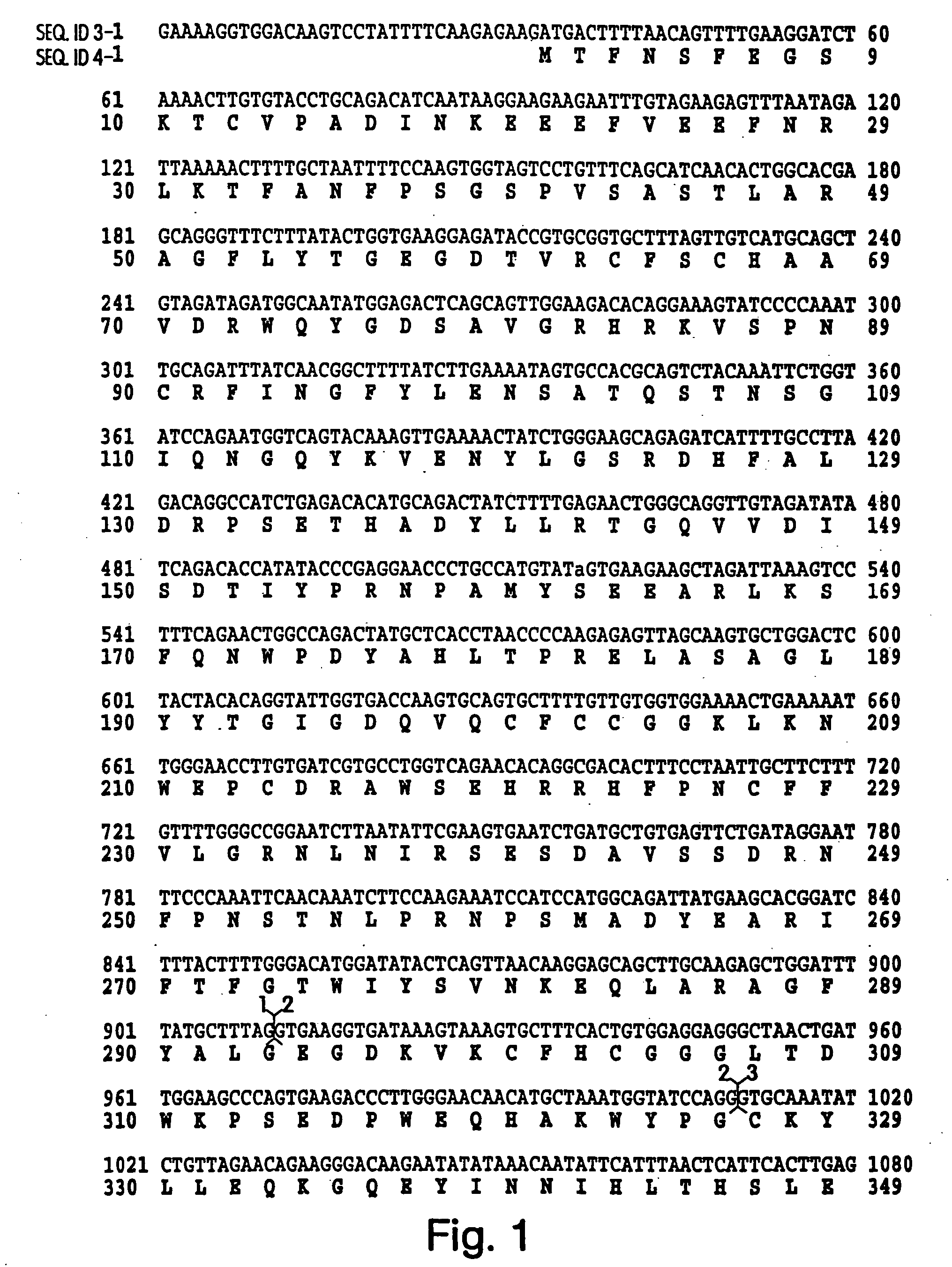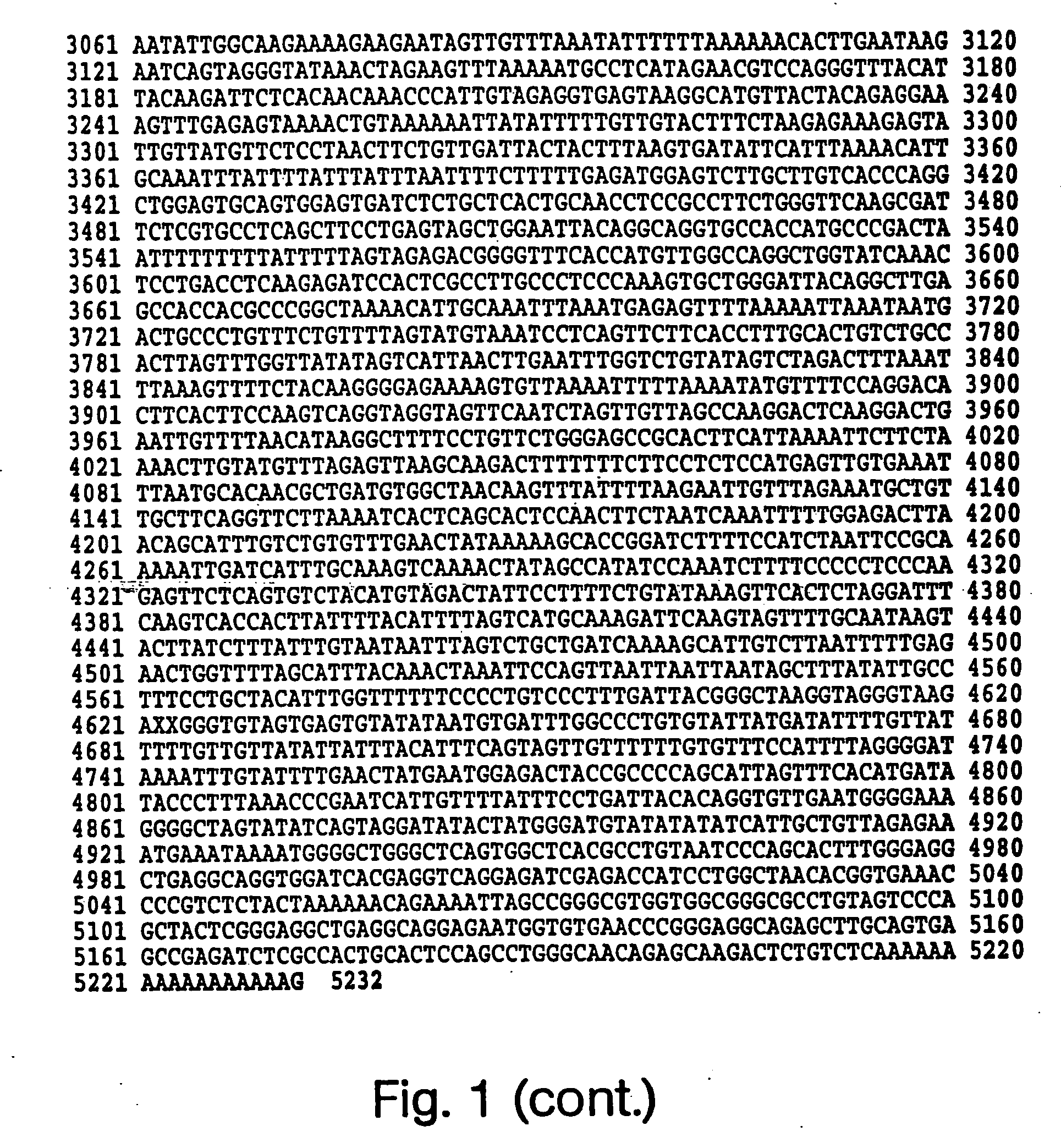Detection and modulation of IAPs and NAIP for the diagnosis and treatment of proliferative disease
a proliferative disease and detection technology, applied in the field of cancer diagnosis and treatment, can solve problems such as poor prognosis, and achieve the effect of facilitating production
- Summary
- Abstract
- Description
- Claims
- Application Information
AI Technical Summary
Benefits of technology
Problems solved by technology
Method used
Image
Examples
example 1
Elevated IAP Levels in Cancer Cell Lines
[0110]In order to specifically demonstrate the utility of IAP gene sequences as diagnostics and prognostics for cancer, a Human Cancer Cell Line Multiple Tissue Northern Blot (Clontech, Palo Alto, Calif.; #7757-1) was probed. This Northern blot contained approximately 2 μg of poly A+ RNA per lane from eight different human cell lines: (1) promyelocytic leukemia HL-60, (2) HeLa cell S3, (3) chronic myelogenous leukemia K-562, (4) lymphoblastic leukemia MOLT-4, (5) Burkitt's lymphoma Raji, (6) colorectal adenocarcinoma SW480, (7) lung carcinoma A549, and (8) melanoma G361. As a control, a Human Multiple Tissue Northern Blot (Clontech, Palo Alto, Calif.; #7759-1) was probed. This Northern blot contained approximately 2 μg of poly A+ RNA from eight different human tissues: (1) spleen, (2) thymus, (3) prostate, (4) testis, (5) ovary, (6) small intestine, (7) colon, and (8) peripheral blood leukocytes.
[0111]The Northern blots were hybridized sequent...
example 2
IAPs in Breast Cancer
[0115]The following data relate to the regulation and role of HIAPs in cancer cells. FIGS. 18 and 19 show data demonstrating that HIAP-1 and HIAP-2 are both upregulated in breast cancer cell lines that contain mutant p53. The lanes contain 20 μg of total RNA from the following lines: 1. MCF-7(clone 1, wt p53) 2. MCF-7 (clone 2, wt p53) 3. MCF-7 (American Type Culture Collection, wt p53) 4. MCF-7 (parental line, California, wt p53) 5. MCF-7 (California, adriamycin resistant variant, mutant p53), 6. MDA MB 231 (ATCC, mutant p53, codon 280) 7.T47-D (ATCC, mutant p53, codon 194) 7. ZR-75 (ATCC, wt p53). The amount of RNA loaded on each gel was controlled for by hybridization with glycerol phosphate dehydrogenase (GAPDH).
example 3
IAPs in Ovarian Cancer
Overview
[0116]Epithelial ovarian cancer is the leading cause of death from gynecologic malignancy. Although clinical and histologic prognostic factors such as tumor grade and surgical stage are well understood, the biologic process that leads to uncontrolled cellular growth is less clear. The control of cell numbers during tissue growth is thought to be the results of a balance of cell proliferation and cell death. An aberration in this natural homeostasis likely contributes to malignant cellular transformation.
[0117]Recent studies on ovarian cancer cell biology have suggested that the deregulation of apoptosis may be one of the underlying pathologic mechanism in this disease. However, the molecular mechanisms involved in its regulation is poorly understood and the role and regulation of the IAP genes in ovarian cell transformation have not been examined previously. Ovarian epithelial cancer is in part a result of suppressed apoptosis of ovarian surface epithel...
PUM
| Property | Measurement | Unit |
|---|---|---|
| Fraction | aaaaa | aaaaa |
| Acidity | aaaaa | aaaaa |
| Biological properties | aaaaa | aaaaa |
Abstract
Description
Claims
Application Information
 Login to view more
Login to view more - R&D Engineer
- R&D Manager
- IP Professional
- Industry Leading Data Capabilities
- Powerful AI technology
- Patent DNA Extraction
Browse by: Latest US Patents, China's latest patents, Technical Efficacy Thesaurus, Application Domain, Technology Topic.
© 2024 PatSnap. All rights reserved.Legal|Privacy policy|Modern Slavery Act Transparency Statement|Sitemap



